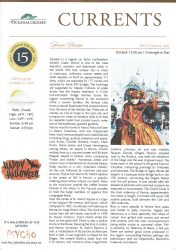| クロアチアの陸地は世界の国のなかで小さく、しかし、地理的に見ても自然を見ても種々雑多です。 北方のリエカ港から南方のドゥブロヴニクまで伸びたクロアチア海岸は、目の覚めるような海の風景、友好的な地元住民、稀な美しさがあります。 クロアチアの真の見せ場は、有名なダルマチア海岸で、素朴なビーチと深青色の海は、クールな地中海とよく合っています。 約1200の島がありますが、66の島だけが人間が住めるといわれ、なかでもダルマチア沿岸は地中海で最大の群島を誇り、水は最も清純かつ澄明です。アドリア海の東沿岸は多くクロアチア共和国に属し、ドゥブロブニク市はその最南端に位置しています。世界には独特だといわれる都市はいくつもありますが、ここドゥブロヴニク市は、古代からの街路があり、さらに石でつくった宮殿、ベネチア様式の建物、鐘楼などが並んでいます。 1979年にユネスコの「世界遺産の宝物」となったのですが、これは数世紀に渡った無数の修復プロジェクトがあり、また、万難を排して行った都市の修復には、妥協は許されない確約があったからだと、自信をもっていえるからです。ドゥブロヴニクに入ると、印象的な歩行者天国のプラツァ通りがあり、町の反対側には時計塔やオノフリア小噴水などがあります。ピレ門の近く、市の城壁のそばには、オノフリオ大噴水があり、ドゥブロヴニクの青年たちにとっては評判のよい会合場となっています。完璧に保存した旧市街はユニークで、大理石で舗装した広場や石畳の街路、背の高い住宅、教会、宮殿、噴水、美術館などは、すべて同じ明るい色の石からできています。 道路や小道には幸いにも車の交通はありません。あるのは人間の精神だけで、活発で、魅力的です。旧市街のツアーは、ほとんどが古代の入り口、ピレ門から始まり、市の城壁を通過します。13世紀から17世紀までに建築したこの壮大な城壁は、全長1940m、壁厚4~6mで、旧市街全体を取り囲んでいます。さらに稜堡数カ所と偉大な要塞2カ所もあり、外敵から守っています。 14世紀につくったフランチェスコ会修道院には、ゴシック様式の玄関と、装飾のある小回廊があります。修道院は、世界で3番目に古い薬局の装具や器具を保存しています。この図書館には、3万点以上の蔵書があり、15世紀から16世紀までの手書きの写本1500点と彩飾した合唱本15点があり、さらに古いクロアチア音楽では沢山の作品があります。 アドリア海岸は、新鮮な魚介類の料理も有名です。車エビ、貝、ダルメシアンブローチ(米で煮込んだ複数の魚)を、オリーブオイルで料理し、茹でた野菜を添えて出てきます。イタリアのピザとパスタは、ダルメシアン沿岸でも名高く、しかも、支払い金額は西欧の半分ほどです。食事の前にブランデーを小グラスで飲み、食事の時にはクロアチアの優れた地方産ワインを飲むのが通例です。クロアチアは梅ブランデー、ハーブブランデー、コニャック、リキュールでも知られています。ザダール地域で作った桜のリキュール、マラスキーノも有名です。イタリア流のエスプレッソコーヒーも地元のお気に入りです。 |
| ドゥブロヴニクのシャトルバスについて 今日、無料のシャトルバスを利用してドゥブロヴニクのピレ門に着くことが可能です。シャトルバスは、船から約40分毎に運行し、午前10時に出発し、最後のシャトルは午後4時に船に戻ります。シャトルバスは先着順で運行し、満席の場合には予定より早く出発します。交通などの予期しない遅延の影響を受けます。タクシーは交通手段の代替形式です。 この無料サービスを使用しない場合、または別の輸送手段を使う場合は、補償はありません。これは地域運行のシャトルバスであり、オセアニアクルーズはシャトル経路の変更や遅延については一切その責任を負いません。 |
Few countries in the world offer as much geographical and natural diversity on such a small land surface as Croatia.
Stretching from the northern harbor of Rijeka to Dubrovnik in the south, Croatia’s coast is a stunning seascape of friendly locals and rare beauty.
The true highlight of Croatia is the legendary Dalmatian Coast, where pristine beaches and deep blue waters merge into the cool Mediterranean.
With approximately 1200 Islands only 66 of which are said to be inhabited, the Dalmatian Coast boasts not only the largest archipelago but also the cleanest and clearest waters in the Mediterranean region. The majority of the coastline along the eastern Adriatic Sea belongs to Croatia, with the city of Dubrovnik situated in the southernmost section of the Republic. Dubrovnik, among the unique cities of the world, is a place of ancient streets lined with stone palaces,Venetian style buildings and bell towers. It was recognized in 1979 as one of UNESCO’s “World Heritage Treasures” due to the numerous restoration projects executed over the past several centuries. Its people take pride in their uncompromising commitment to the restoration of their city at all costs. Entering Dubrovnik, you are greeted by an impressive pedestrian promenade, the Placa, which extends before you all the way to the Clock Tower and Small Onofrio Fountain at the other end of town. Just inside the city walls near the Pile Gate is the Large Onofrio Fountain a popular meeting spot for Dubrovnik’s young population. The entire perfectly preserved old town is unique for its marbled-paved squares as well as its cobbled streets, tall houses, churches, palaces, fountains and museums, all cut from the same light colored stone.
Streets and lanes are blessedly free of vehicular traffic and the human spirit prevails in a vibrant and inviting manner. Most tours to the old city begin at the ancient entrance at the Pile Gate, where you will pass through the city walls. Built between the 13th and 17th centuries, these great walls measure 6200 feet in length are 3 to 19 feet thick and encompass the entire old town. Several bastions and two great fortresses guard each approach.
Dating from the 14th century, the Franciscan Monastery has a remarkable Gothic porch with a small ornamented cloister. The monastery preserves the equipment and utensils of the third-oldest functioning pharmacy in the world. The library contains more than 30,000 volumes including 1500 manuscript, 15 illuminated choral books from the 15th and 16th centuries, and numerous works of old Croatian music.
The Adriatic Coast excels in fresh seafood dishes ranging from scampi, shellfish and Dalmatian brodet (mixed fish stewed with rice), all cooked in olive oil and served with boiled vegetables. Italian pizza and pasta are also good options on the Dalmatian Coast, costing about half of what you would pay in Western Europe. It’s customary to have a small glass of brandy before a meal and to accompany the food with one of Croatia’s fine regional wines. Croatia is also known for its plum brandies, herbal brandies, cognacs and liqueurs such as maraschino, a cherry liqueur made in Zadar. Italian-style espresso coffee is also a local favorite.
SHUTTLE BUS SERVICE IN DUBROVNIK
Today in Dubrovnik guests may use complimentary shuttle buses to reach Pile Gate. The shuttle buses will run approximately every 40 minutes from the ship beginning after at 10:00 am with the last shuttle returning to the ship at 4:00 pm. Shuttle buses are operated on a first come, first served basis and may depart earlier than scheduled if filled to full capacity. Shuttle buses are subject to unforeseen delays such as traffic. Taxis are an alternative form of transportation. No compensation is due for non-use of this complimentary service or if alternate forms of transportation are used. As this is locally operated shuttle bus services, Oceania Cruises is not responsible for any changes or delays to the shuttle schedule.
